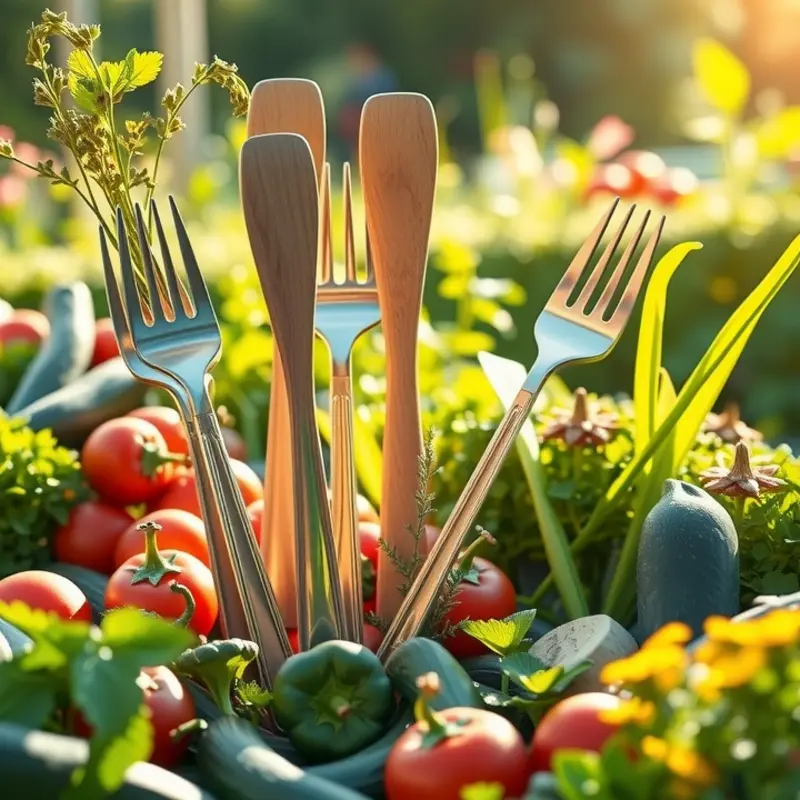Eating is not just about food; it’s also about how we consume it. From chopsticks in Asia to forks in the West, the utensils we use are laden with cultural significance. As food enthusiasts delve into various cuisines, understanding these traditional tools can enrich the dining experience and highlight the beauty of culinary diversity.
Chopsticks: A Dance of Precision and Grace

Chopsticks serve as an iconic symbol within many Asian culinary traditions, particularly in China, Japan, and Korea. Their history dates back thousands of years, with the earliest records of chopsticks emerging from ancient China over 5,000 years ago. Initially used for cooking, chopsticks gradually found their place at the dining table, reflecting a shift in culinary practices and societal evolution.
The elegance of chopstick use rests in their simplicity and the skill required to wield them effectively. Each region has developed its own unique style and traditions surrounding these utensils. In China, chopsticks are typically longer, reflecting their primary function in communal dining and the ability to reach across a shared table. Moreover, the Chinese design is often symbolized by intricate patterns and designs etched into wood, bringing an aesthetic value to their functionality.
Japanese chopsticks, or ‘hashi,’ are shorter, often tapered to a point, which aids in the precise handling of smaller bits of food, like rice or sashimi. The Japanese culture has elevated chopstick crafting to an art form, using materials such as lacquered wood or even ivory. Etiquette is steeped in Japanese chopstick use, dictating not only the manner in which they should be held but also not to cross them or stick them upright into a bowl of rice, as these actions are associated with funerary rites.
In Korea, chopsticks are typically made from metal, a tradition stemming from the royal courts where silver chopsticks were employed to detect poison. Today, stainless steel is a common choice, demonstrating longevity and sustainability, as a nod to eco-friendly practices. Moreover, Korean chopsticks tend to be flatter compared to their rounder counterparts in China and Japan, adding a unique tactile aspect to dining.
Beyond their physical form, chopsticks often serve as a window into broader cultural nuances. The act of serving food to others, for instance, holds a period of significance, with special chopsticks often set aside specifically for serving, to avoid direct mouth-to-mouth contact via utensils. In contrast to the Western practice of cutting food before it is served, many Asian dishes are presented in bite-sized portions, showcasing the linkage between food preparation and utensil use.
Mastering the use of chopsticks is more than just an exercise in dexterity; it is an introduction to a world of deeply ingrained rituals and practices. As global cuisine continues to blend traditions, many find themselves incorporating these graceful tools into their dining experiences. Whether crafted from simple bamboo or elaborately decorated with lacquer, chopsticks remain a testament to the confluence of practicality and cultural expression.
To further delve into the diverse tapestry of food culture, explore culinary influences and how trade has shaped global dining practices. This understanding highlights the pivotal role utensils like chopsticks play in preserving tradition amidst changing culinary landscapes.
The Fork: An Evolution of Culinary Craft

Often overshadowed by its companion, the knife and spoon, the fork’s journey from obscurity to table staple is a fascinating one. Initially, it was no more than a concave-tipped utensil used primarily for cooking, rather than for eating. This humble beginning traces back to ancient Rome, where the fork appeared as a two-pronged tool, mostly utilized for carving meat or holding food steady.
The fork’s transition from the kitchen to the dining table began in the Byzantine Empire around the 7th century. It was in Constantinople that the fork took on a more refined form, with a distinct aesthetic appeal. Royals and nobility used it as a symbol of sophistication. These early versions were typically made from silver or gold and often featured intricate engravings.
Fast forward to the 11th century, the fork made its way into Europe, carried by a Byzantine princess who introduced it to Venice. Yet, even within the courts of Europe, it faced resistance. Many viewed it as a frivolous luxury. It wasn’t until the Renaissance that the fork carved a niche for itself in the culinary culture of Europe. This period marked the beginning of the understanding that cutlery could enhance the dining experience, influencing both manners and food presentation.
The fork’s acceptance skyrocketed in the 16th and 17th centuries, popularized by the French court. It became a symbol of polite society, reflecting evolving social norms surrounding dining. This period also brought the standardization of fork types, designed for different dining purposes.
Today, the fork is a versatile tool with a variety of designs supporting diverse culinary practices. In Western cuisine, there are several specialized types, including the salad fork, whose broader, flatter design aids in handling greens. The fish fork, with its wider prongs, is adept at separating delicate fish flesh. Pasta, a beloved staple across many cultures, has not one but often two forks—one for twirling spaghetti, and a larger serving fork used to manage those slippery noodles.
Similarly, dessert forks showcase shorter, sharper prongs, suited to handling sweets without losing grip. Seafood forks, on the other hand, are slender and elongated, perfect for extracting meat from shellfish. This diversity in design reflects not only a refinement in culinary techniques but also mindfulness towards the dining experience, encouraging a more thoughtful approach to eating practices.
The fork’s trajectory from a simple spear-like tool to a refined dining instrument is emblematic of wider changes in culinary habits and social norms. For those interested in further exploring the cultural impacts of dining utensils, examining the culinary influences of trade offers deeper insights into how such tools have become integral to global food culture. For more on this, visit Culinary Influences Through Trade. As eating habits continue to evolve, the fork remains a testament to the rich tapestry of human history and ingenuity.
Final words
Exploring the world of traditional eating utensils opens a window into the cultures that have shaped our culinary experiences. Each tool tells a story, from chopsticks used in Asia to the renowned fork in the West. As global food enthusiasts, embracing these cultural artifacts not only enhances our appreciation for different cuisines but also allows us to connect deeper with the traditions and history behind the meals we enjoy. Next time you sit down to eat, consider the utensils in your hand—they are vessels of heritage and artistry.








